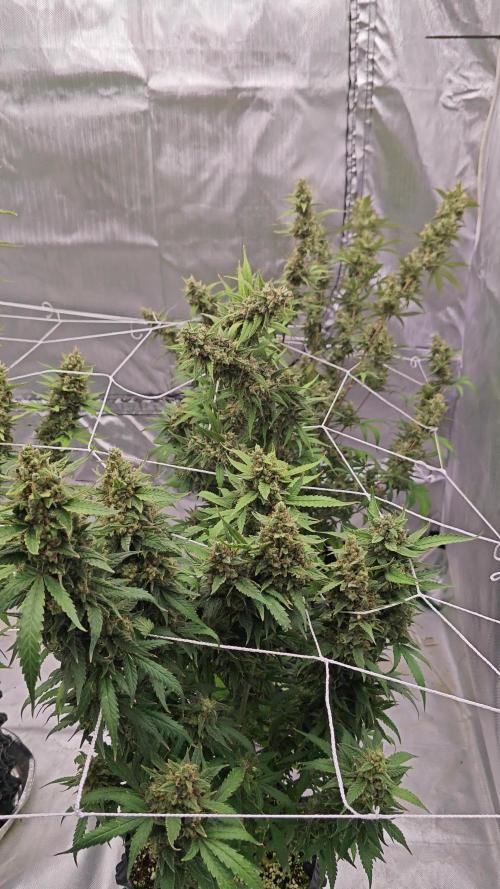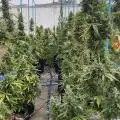The Grow Awards 2026 🏆 





































Likes
Comments
Share


@OS_Farmz
Follow
This week will be the last one for these babies, already started flushing them with water. Plan to continue so for 2-3 more days until reach around 700-600 ppm and Bob is your uncle. It was my first experience with auto flowering strains. It gives much less amount of products comparing to photo, but less stress as well, easy growing, plants are quite are unpretentious. Let's see how potent they will be.
Likes
34
Share


@Birale91
Follow
Harvested on day 113 after ending week 9 of bloom. after washing week ago with adding flora kleen and then after 3 days turn light to 48 hours darkness before harvest.
First trim in harvest defoliated big fan leaves with all the leaves without sugar and the tip of the small leaves.
When the buds will be dry ill do second trim untill the bud will be like dense diamond.
So, really love this strain and i give her a score of 9/10.
First, for the buds beauty,dense.
purple,red,yellow,pink and blue are showing on buds and its realy amazing.10/10.
Smell are very sweet and strong of grapes.9/10.
Taste is very fruity sweet grapes and i like it.9/10.
Very strong effect on mind but feel very good.9/10.
So, for final, 9/10.
Something like week drying and ill update more pics and videos.
*Added video of drying buds at day 4.
*Added video and pics of well dried buds.
ill add more stunning pics soon.
Likes
2
Share


@TheBudWhisperer
Follow
Week 10 to the day and it’s time for the chop. Won’t be a whole lot see in that regard. It’s all being hand trimmed, packaged and frozen fresh - right from the plant.
Then processing via bubble bags, pressing for live rosin, decarbed and finally - carted.
I’m guessing about a years worth of vapable concentrate.
Likes
16
Share


@Mrg7667
Follow
About day 38 i am just realizing that i am stupid and been feeding the biogrow for cocoa coir 🤦♂️ way iver nuting with soil it says never to go over 1ml/L
So i will be flushing for at least 1 or two waterings. Looking for the tip burn to stop spreading and the tips to not look like there clawing
Likes
10
Share


@berlinbeginner
Follow
Day 34 veg
BM1 responding well to topping. Vigorous growth.
BM2 growing normal
BM3 has tight internodal spacing.
BM4 grew slower than the others but didnt get topped at all.
I started feeding today 0.5ml/l biobizz grow.
Problem with watering: pots dont get watered properly. Water just runs off of the bottom.
Processing
Likes
37
Share


@Chunkmasta1
Follow
Some explosive growth This week. She has calmed down on the drinking a little. The ph has stayed pretty level between 5.6 to 5.8 all week. Pistols are really starting to make an appearance. This will be the last week she gets the transition set of nutrients. I added another 450w viparspectra for flower. Sorry about some of the darker pics I got home right as the lights went out tonight. The smell is still light not heavy at all. She filled the scrog well. I am so surprised at how well this plant is doing now it’s like nothing ever happened. Plant got about 17 hours of dark yesterday do to my power going out cause someone hit a telephone pole in the neighborhood..... back on schedule today and we are at day 13 of flip. According to breeder we have about 8 more weeks to go. I’m no expert but I think she is done stretching (i think)..... I can say as a beginner grower this is an excellent strain so far for my level of experience. Been a little cold at night here but so far no issues
Likes
17
Share


@420DeepGrow
Follow
Gracias al equipo de AnesiaSeeds, Marshydro, XpertNutrients y Trolmaster sin ellos esto no sería posible.
💐🍁 Violet Face:
Esta variedad feminizada es como un dream team de la realeza del cannabis, que mezcla la majestuosa Blue Face con las frías vibraciones de la Frozen Black Cherry. Es como el perfecto día de verano: vibraciones soleadas con una brisa fresca.
Blue Face aporta esa refinada magia Z, con notas cremosas de naranja y pastel de plátano que te harán sentir como si estuvieras en un paraíso tropical. A continuación, Frozen Black Cherry entra en escena con su aspecto escarchado y su aroma a cereza dulce y ácida que es sencillamente adictivo.
Sube el volumen porque Violet Face golpea fuerte con niveles de THC que se disparan hasta el 35%. Cada calada es un billete al paraíso, que combina los lujosos aromas de la cereza con una embriagadora mezcla de dulzura y sabor afrutado.
Violet Face no es sólo un estilo de vida relajado; también es una campeona de peso pesado, con rendimientos de 600 g/m² en interior y unos exuberantes 900 - 1200 g por planta en exterior. Esta belleza florece en 8-9 semanas, y está lista para la cosecha a finales de septiembre. Tanto si la mantienes acogedora en interior como si la extiendes bajo el cielo, Violet Face se extiende con alturas de 80-120 cm en interior y 160-200 cm en exterior.
🌻🚀 Consigue aqui tus semillas:
💡TS-3000 + TS-1000: se usaran dos de las lámparas de la serie TS de Marshydro, para cubrir todas las necesidades de las plantas durante el ciclo de cultivo, uso las dos lámparas en floracion para llegar a toda la carpa de 1.50 x 1.50 x 1.80.
https://marshydro.eu/products/mars-hydro-ts-3000-led-grow-light/
🏠 : Marshydro 1.50 x 1.50 x 1.80, carpa 100% estanca con ventanas laterales para llegar a todos los lugares durante el grow
https://marshydro.eu/products/diy-150x150x200cm-grow-tent-kit
🌬️💨 Marshydro 6inch + filtro carbon para evitar olores indeseables.
https://marshydro.eu/products/ifresh-smart-6inch-filter-kits/
💻 Trolmaster Tent-X TCS-1 como controlador de luz, optimiza tu cultivo con la última tecnología del mercado, desde donde puedes controlar todos los parametros.
https://www.trolmaster.com/Products/Details/TCS-1
🍣🍦🌴 Xpert Nutrients es una empresa especializada en la producción y comercialización de fertilizantes líquidos y tierras, que garantizan excelentes cosechas y un crecimiento activo para sus plantas durante todas las fases de cultivo.
Consigue aqui tus Nutrientes:
https://xpertnutrients.com/es/shop/
📆 Semana 9:
El engorde de los cogollos está prácticamente terminado y solo falta que maduren un poco antes de ser cosechada.
Gran trabajo por parte de mis colaboradores, estoy bastante contento con este grow, el próximo tendré más atención en la etapa de crecimiento, la cual es muy importante si quiero obtener una cosecha de calidad.
A partir de ahora agua hasta el fin.
Likes
9
Share


@JeyGanesha
Follow
Anche a questa runtz gli ho fatto un Super hst ........
Ho porterò delle altre amiche mie (larve di coccinelle) per fargli tenere punte le mie piante sacre😊😉👍💪
....lotto biologica.
Likes
48
Share


@TheCannaProphet
Follow
~ WEDDING CHEESECAKE FAST FLOWER by FastBuds ~
Well fam, here we go again with another epic strain from FastBuds Fast Flowering stable. After having such tremendous success growing their Gorilla Cookies Fast Flower outdoors last year, I've decided to run another of their fast flowering strains outdoors this year... Wedding Cheesecake Fast Flower!
The best description of this awesome cultivar comes directly from my friends at FastBuds which is as follows:
"A delight for the mind and body: Wedding Cheesecake FF (Fast-Flowering) is a delicious strain that offers XXL yields in a 7-8 weeks flowering cycle. This terpene powerhouse produces loads and loads of mouth-watering vanilla-creamy-cookie-scented terps with hints of citrus and cinnamon. In addition to its delicious aromas, this variety grows very well in both indoor and outdoor setups, yielding up to 650 g/m2 without extra maintenance, making it the ideal strain for beginners as it allows you to maximize yields while minimizing work. This super-fast feminized photoperiod version offers upbeat and energetic yet deeply relaxing effects that are perfect for consumers looking for a heavily focused, motivating, and creative high. It’s the ideal strain for those needing that extra energy boost to start a busy day on the right foot.
Wedding Cheesecake FF boasts chunky, large-sized buds with a thick layer of silvery-white resin and bright orange hairs scattered all over: that just screams ‘quality’. The lime-green flowers sparkle with an array of hues ranging from dark to light green, to magenta and purple, and reek of a delicious aroma that’ll remind you of fresh store-bought cheesecake.
This is an XXL hybrid that grows extremely tall in height, reaching up to 3m with one huge main cola and multiple long side branches that can withstand enormous yields of up to 650 g/m2 with ease. Wedding Cheesecake FF is extremely resilient to the elements and can be grown in almost every climate as long as you’ve got the space and basics covered, making her an excellent choice for those looking for large-scale harvests with a quick turnaround time without much effort."
________________________________________________________________________________________________________________________________________________________________________________________________________________________________________________________________________________________________________________________
The Setup:
This is going to be an outdoor grow, but I have started the Wedding Cheesecake FF indoors as our weather is still too cold to put her outside (nighttime temp's dipping regularly into the 30's℉).
The plan is simple... let her grow inside under a 19/5 light schedule until the nighttime temperatures stay above the mid 40's℉, at which point she'll be moved outside and transplanted into the soil which I have already setup and inoculated with beneficial microbes, and then let the fun begin!🤪💚
________________________________________________________________________________________________________________________________________________________________________________________________________________________________________________________________________________________________________________________
Weekly Updates:
6/18- Week 12 and the Wedding Cheesecake Fast Flower from FastBuds is on a mission! The amount of growth happening right now can only be described as explosive, with new shoots appearing and existing branches going crazy with growth!
6/20- Our summer is here and we're under an early heat wave this week with daytime temp's hitting the mid to upper 90's ℉ with heat indexes in the low 100's ℉... in short, IT'S FNG HOT!🔥🔥🔥
I'm watering the Wedding Cheesecake FF daily now with 5-7g of straight well water from the garden hose. I'm watering at sundown so that the water will have some time to soak down into the soil before the heat evaporates it. The coating of straw that I previously spread over the soil has helped a lot as well.
6/22- The weather continues to relentlessly bake everything outside... many thanks for a good A/C!❄️
The daily watering continues and I also went ahead and removed a bunch of foliage that was below the trellis net.
6/24- Today I top dressed the FastBuds Wedding Cheesecake FF with 2 cups each of Gaia Green 4-4-4 and 2-8-4 along with 1 cup of Down To Earth Bio-Fish 7-7-2 and 1/2g of Wiggle Worm castings. After top dressing and working the amendments in by hand I replaced the straw coating over the soil and watered them in with 5g of straight well water via garden hose as usual.
There goes another week for the Wedding Cheesecake FF and it won't be long before she begins to show signs of pre-flowering!
Thank you for checking out my diary, your positive comments and support make it all worthwhile! 💚Growers Love!💚😎🙏
Likes
46
Share


@exclusiveX420
Follow
Will update the GG harvest week with this info but Dry results for Gorilla Glue 2 gallon was 28.4 grams usable smoke with tons of really good auger leaves I ground up for keef. It made alot of keef ! Very airy buds. No where near the density I would like and this was the same for my 1 gallon GG grow however that actually turned out more sense than this. Covered in Trichomes and smell isn't placeable yet but it doesn't smell like grass and it doesn't smell like weed. Idk what it smells like lol. Now in cure
Update day 101 for Bruce banner and GSCE Both still rolling along and doing very good. GSCE since Friday has legit frosted over like a high times magazine. Wow! But just needs more time yet. Very excited to finish these too but being very patient with these last 2. Looking forward to harvest.
PS Bruce banner smells so strong kllile skunk piss if it was outside you would smell it for 100 yards and it's only a 1 gallon pot grow. Un freaking real! Citrus/skunk piss lol. So strong it blows me away! I love it! GSCE update, it's official the buds are like mini bricks that would break a window they are so dense! 😍😀 Super excited. Thanks for following along. Stay tuned.
Likes
11
Share


@HIAZ_urbanbudfarmer
Follow
Sounds like another great strain to grow, 27% T.H.C., up to 600 grams per square metre, 70% indica & around 7 weeks of flowering. Plan is to mainline her currently week 2 day 9 of veg, started her straight into rock wool & sprouted in a few days. Started her on nutrients after a few days at 0.75ml per litre & increased to 2ml per litre start of week 2 & planted into final home, 15 litre pro pot going great.
Processing
Likes
24
Share


@Lowkey_Doc
Follow
Week 6 Day 38 of flower 08/14/2020
~Average~
Temp: 76-84f
RH: 42%
Ph: 5.9-6.2
Notes: Everything is right on schedule.
These ladies are swelling by the day, trichromes production is still at large. The trichromes are starting to be noticeable from the eye.
I checked with my digi scope and the trichromes are mostly clear with milky, little to no amber. I will keep my eye on those these next couple of weeks.
Happy cultivating✌️🏽
Likes
9
Share


@Mr_nugs_lover_David
Follow
Hello everybody!!,I'm very very sad this time guys,a few weeks ago I had some kind of fungal infection because humidity went to high with the rain and I had to take away 3 of this 4 ladies plus the other one I lost at the beginning because they were 5 and it was due also to a fungal infection however she was in seedling stage and I got the evil dumping off,the good news is that I'm enjoying soo much the only one I have,she's in full flowering and she's producing amazing sweet terps,you can't imagine how disappointed I am,I would have loved to have my 5 girls in full flowering now,I'll griw her Photoperiod version no matter what,I'm in love with her suoer floral and sweet aromas,I recomend this strain to everyone,you will enjoy her so much.peace growmies and cannalovers! ❤️💚💛🌱✌️ #LEGALIZEIT!!!!!!
Likes
295
Share


@Ju_Bps
Follow
Hello growmies 👩🌾👨🌾🌲🌲,
👋 This week growing well, Preflowering started.
💡 I up a bit the supply of lamp each days.
💪 I've started the training.
💧 Give water each 2/3 day
And vaporise plant with water + Plagron Roots (1ml/l)
0.5 l Water + Roots + Easy plus
0.6 l Water + Roots + Grow
0.7 l Water + Roots + Grow
PH @6
RQS - Easy Grow Booster Tabs
1 tabs/5 l
RQS - Easy Micronutrients Plus
1 tabs/5l (1 watering each 10 days.)
💡Mars Hydro - FC 3000
27% 60 cm.
Mars Hydro Fan kit
Setting 5
Have a good week and see you next week 👋
Thanks community for follow, likes, comments, always a pleasure 👩🌾👨🌾❤️🌲
Mars Hydro - Smart FC3000 300W Samsung LM301B LED Grow Light💡💡
https://www.mars-hydro.com/fc-3000-samsung-lm301b-led-grow-light
Mars Hydro - 6 Inch Inline Fan And Carbon Filter Combo With Thermostat Controller 💨💨
https://www.mars-hydro.com/6-inch-inline-duct-fan-and-carbon-filter-combo-with-thermostat-controller
RQS - Titan F1🌲🌲
https://www.royalqueenseeds.com/f1-hybrid-cannabis-seeds/624-titan-f1.html
Likes
16
Share


@JohnnyBlaz3
Follow
Wow what a strain! The flowers are absolutely caked with trichs, making the flowers look heavily frosted. The smell is pungent and pretty dank smelling. The taste I find to be pretty mild. Where this strain stands out is the very powerful punch it packs! WOW lol this one will have you staring at a blank tv screen for 30 minutes before you remember what you were doing lol no complaints on this strain, have it growing again this run too! Thanks for following along!!! On to the next one!
Likes
14
Share


@KannaKullektiv
Follow
Aloha Freunde der Sonne 😊
Heute wurde das letzte Mal so richtig entlaubt. Nicht ganz Lollipop aber für mich reicht das vorerst.
Ich muss klar sagen das ich noch nie so einen schönen Geruch in der Nase hatte. Ich freue mich auf die Ernte.
Viel Spaß 🙏
Likes
3
Share


@qwerty192837
Follow
Ich selektiere diese Woche die drei besten Keimlinge und stecke sie in 39l Stofftöpfe (ca30l Substrat) mit einer 70:30 Mischung Bio Bizz all mix und Coco.
Likes
5
Share


@84ruk
Follow
Primera semana en un sustrato malo del cual fue trasplantada la siguiente semana
Likes
22
Share


@Naujas
Follow
a new air pot has been replaced, and a new "Girl", I have very limited space, so I don't even know how I will do:) an interesting trip awaits, I will soon start making a timelapse video :).



















